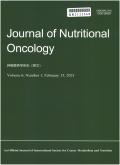Associations of the Fat-age-inflammation Index with Overall Survival in Patients with Metastatic Lung Cancer
引用次数: 0
Abstract
Abstract: Background Metastatic lung cancer (LC) is a threat to human health. We previously proposed a fatage-inflammation (FAIN) index which showed prognostic value in patients with certain cancers. However, whether a similar association exists in patients with metastatic LC remains unknown. Methods We performed a cohort study including 1360 patients with metastatic LC from January 2013 to April 2019. The FAIN index was defined as: (triceps skinfold thickness + albumin) / [age + 5 × (neutrophil count/lymphocyte count)] × 100%. Sex-specific cutoffs of the FAIN were determined using an optimal stratification approach. The associations of the FAIN index with the nutritionrelated factors, short-term outcomes and overall survival (OS) of patients were comprehensively assessed. Results The study enrolled 865 males and 495 females with a median age of 59.9 years. The continuous FAIN was significantly associated with the OS in both genders (both P < 0.05). The optimal stratification-defined FAIN cutoffs were 82 for women and 60 for men. A total of 623 patients (45.8%) were categorized as having a low FAIN. A low FAIN was associated with poorer nutrition-related factors and impaired short-term outcomes including the thirty-day mortality, length of hospital stay, intensive care unit stay and cost (all P < 0.05). Multivariate Cox regression analysis revealed that a lower FAIN was also associated with an increased death hazard (HR = 1.428, 95%CI = 1.209-1.686). Conclusion This study assessed the FAIN index, which might act as a feasible tool to monitor nutrition-related factors and help develop management strategies to optimize the clinical outcomes of patients with metastatic LC.转移性癌症患者脂肪炎症指数与总生存率的关系
摘要:背景转移性癌症(LC)是一种威胁人类健康的疾病。我们之前提出了一种脂肪炎症(FAIN)指数,该指数对某些癌症患者具有预后价值。然而,在转移性LC患者中是否存在类似的关联仍然未知。方法我们对2013年1月至2019年4月的1360名转移性LC患者进行了队列研究。FAIN指数定义为:(三头肌皮褶厚度+白蛋白)/[年龄+5×(中性粒细胞计数/淋巴细胞计数)]×100%。使用最佳分层方法确定FAIN的性别特异性截止值。对FAIN指数与营养相关因素、短期疗效和患者总生存期(OS)的相关性进行了综合评估。结果本研究纳入865名男性和495名女性,中位年龄为59.9岁。两种性别的持续性FAIN均与OS显著相关(均P<0.05)。最佳分层定义的FAIN临界值女性为82,男性为60。共有623名患者(45.8%)被归类为FAIN低。低FAIN与较差的营养相关因素和受损的短期结果相关,多因素Cox回归分析显示,较低的FAIN也与死亡风险增加有关(HR=1.428,95%CI=1.209-1.686)。结论本研究评估了FAIN指数,这可能是监测营养相关因素的可行工具,并有助于制定管理策略以优化转移性LC患者的临床结果。
本文章由计算机程序翻译,如有差异,请以英文原文为准。
求助全文
约1分钟内获得全文
求助全文

 求助内容:
求助内容: 应助结果提醒方式:
应助结果提醒方式:


